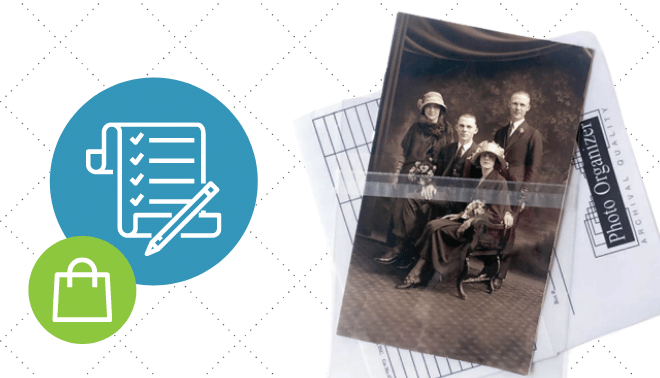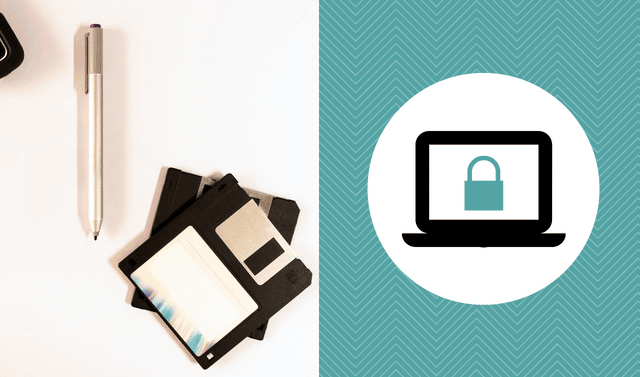Sign up for the Family Tree Newsletter Plus, you’ll receive our 10 Essential Genealogy Research Forms PDF as a special thank you!
Get Your Free Genealogy Forms
"*" indicates required fields
Many genealogists quickly discover they have become family archivists as well as family researchers. Word spreads like wildfire when relatives learn we are happy to take the old photo albums and loose papers cluttering their garage. Soon, more pictures, documents, and artifacts are likely to come our way.
With the right tools and supplies at hand, organizing and preserving family treasures doesn’t have to be complicated or overwhelming. Extend your genealogy toolbox to include basic archival supplies and know-how, and you will be ready to confidently care for the next family treasure that comes your way.
Use our guide and expert tips to help you select and use the proper archival materials for photos, newspapers, artifacts and more.
ADVERTISEMENT
Archival Terms to Know
Archivists use a basic vocabulary to describe the preservation-quality supplies used in their work. Make these terms part of your Archivist’s Toolbox to help you easily select the best containers to store your family materials.
Acid refers to the pH of a product, often paper or heavy-weight paperboard. Newsprint and other cheap paper is made from wood-pulp or other organic fiber and has a high “acid” content measuring a pH of less than 7.0. Acidic paper quickly yellows and becomes brittle in light and heat.
Acid migration occurs when high-acid materials come into contact with other items and cause brown stains or a change in colors. You may have seen color photos stored in plastic photo pages or “magnetic albums” of the 1970’s that show this color fading from the acidic materials.
ADVERTISEMENT
Acid-free, true “archival” products are free of wood-pulp and other organic materials that can damage paper, photos, and artifacts. These products have a pH of 7.0 or more and have been made from non-wood pulp products or been treated to neutralize any acid.
Lignin-free or low-lignin items are free or limited amounts of lignin, an organic substance that can cause acid to form in storage containers over time.
Buffered archival paper has been treated to neutralize the potential build-up of acid over time. The most common buffering agents are calcium carbonate and magnesium carbonate.
Photographic Activity Test (PAT) is a standardized test to determine how photo storage materials interact with photographs. It is used mostly with plastic storage sleeves and containers. Polyester, polyethylene, and polypropylene are chemically inert plastics and acceptable for sleeves and enclosures. Any plastic containing polyvinyl chloride (PVC) is not recommended.
Find more information on archival terminology at Gaylord Archival.
Top Ten Archival Supplies
1. Acid-free File Folders
Archival acid-free file folders are a document’s first line of defense against environmental hazards. The heavy-weight board provides protection from handling, light, dust, and minor liquid spills. Folders are available in letter or legal size with full edge or third cut tabs for labeling. Store folders vertically inside an acid-free document case or a metal filing cabinet. Organize materials further with acid-free vertical hanging folders.
2. Flip-top Document Case
Archival document cases are designed to be portable file cabinets for selected document collections. File folders can be easily organized and stored vertically inside the box and retrieved for researchers. These sturdy acid-free boxes are perfect for home archives and can be stored on a closet shelf or inside a cupboard.
Consider weight as well as size when selecting containers. Archival materials are heavier than average cardboard, and large documents cases can become very heavy when filled with acid-free file folders and documents.
Document cases are made in varying colors, length, and width. Box color does not affect archival quality and may be useful to separate family collections. Select the length, legal or letter, to accommodate your papers housed inside acid-free folders. Typical box widths are 2-inch, 5-inch, and 7-inch. The small 2-inch is useful for small collections. I use the middle 5-inch wide cases because the larger box can become quite heavy when full.
3. Oversize Document or Photo Box
Large, shallow archival boxes and large acid-free folders are a good choice for archiving land deeds, wills, or maps. Avoid stacking too many items in the box to avoid abrasion from sheets rubbing together. Protect individual items by placing inside an oversize archival folder or plastic sleeve.
4. Newspaper Preservation Kit
Full-size newspapers need special attention before they join other papers in your family archive. Use oversize archival newspaper boxes and folders to store the papers. Place buffered paper between pages to slow down deterioration. Newspapers are inherently toxic and will damage adjacent materials over time. Isolate any newspapers or items on newsprint you wish to preserve. Avoid storing newspapers in the same box or folder as other documents to avoid damage from acid migration.
The Newspaper Preservation Kit is a good way to preserve a small collection of papers and can be used to save any kind of oversize document or photograph. The kit includes white cotton gloves, acid-free folders, and drop-front box.
5. Acid-free Tissue Paper
When fragile albums or books need extra cushioning inside an archival box, reach for the acid-free tissue paper. Lightly crumpled tissue prevents book corners and edges from damage. It’s also a good first layer wrapped around artifacts such as children’s shoes, antique quilts, or heirloom linens. Use unbuffered acid-free tissue for all-purpose storage.
6. Acid-Free Flip-Top Photo and Print Box
Flip-top boxes are a good choice to store photos and snapshots. Select a box size close to the size of your prints and store photos vertically on the long edge. You may want to use separate boxes for cabinet cards and 20th century black-and-white snapshots.
Individual prints can be protected for viewing with archival plastic photo sleeves or paper photo sleeves. Select sleeves for the appropriate photo size to avoid abrasion from the print sliding around inside the enclosure. Use acid-free dividers to help organize images by family group, date, or individual. Remember to wear gloves when handling photos to avoid leaving fingerprints and body oils.
7. Archival Albums
Photos, negatives, letters, newspaper clippings, or other documents can be organized and preserved in acid-free albums using archival pages or plastic sleeves. Avoid mixing items printed on high-acid newsprint with other items. Use only archival, P.A.T. approved plastics and acid-free backing paper for your images. Choose albums with slipcases that stand upright like a book, or preservation box albums with integrated binder rings and clamshell cover and store upright or flat on a shelf.
8. Negative Preservers
Polyethylene negative preservers organize and protect film from fingerprints and dust. Sheets are available for various size negatives, either punched for binders or unpunched for storing inside an acid-free folder or box. Remember to wear gloves when handling film. Label negatives with date, names, or events along the edge using an acid-free micron pen.
9. Slide and Media Boxes
Archival boxes are available for almost every imaginable media from antique stereo cards to VHS tapes. Select the appropriate size for your media and consider digitizing old 16mm and 30mm films as well as home movies made on VHS tapes. This older media has a short lifespan and will last longer when digitized and stored on an external hard drive with back-ups.
10. Archival Blue E-flute Quilt Preservation Kit
Quilts, military uniforms, and wedding dresses are bulky and heavy. Use this large, lightweight archival box to preserve heirloom textiles. The acid-free box is made from corrugated E-flute board and is a better choice than storing inside a wooden drawer or cedar chest where acidic wood can damage the fabric. The kit includes white cotton gloves to wear when handling textiles and acid-free tissue to layer folds and cushion sleeves. Before storing, have the item professionally dry cleaned by a local company experienced with vintage textiles.
My Essential Archival Tools
White cotton or nitrile disposable gloves: Keep a pair of gloves handy to wear whenever you are working with photos, film, or negatives to avoid leaving fingerprints. Gloves are also essential when handling textiles and old paper to avoid leaving oils from your hands.
No. 2 pencil: Use a soft lead pencil when working with documents to avoid leaving unintentional ink marks. Write captions lightly on the reverse side of photos printed on paper or board.
Micron acid-free pen: Snapshots often have a glossy back that resists pencil; use a scrapbooking acid-free pen instead.
Micro-spatula: This small metal tool helps turn fragile pages, remove sticky wax from magnetic photo albums, and carefully lift photos off album pages.
Polypropylene label holders: Self-adhesive pockets hold slip-in cards to label document cases, binders, and archive boxes.
9 Expert Archiving Tips
- Use storage containers and materials manufactured to be archival quality, acid-free, and lignin-free.
- Avoid recycled products. These contain unknown materials.
- Use known plastics labeled “archival” or “P.A.T. Approved.”
- Purchase from reputable companies that supply libraries, archives, and universities.
- Use the best-fit archival container for your items.
- Archival containers are interchangeable. A shoebox-size “photo box” can also be used to store a pair of baby shoes wrapped in acid-free tissue.
- Improvise when necessary, but always place your artifact so the contact surface is the best available archival material. Store a small photo album inside an acid-free folder if an acid-free box is unavailable.
- Maximize your storage space by selecting one or two sizes when purchasing archival boxes and document cases. Uniform sizes can fit on the same shelf and use one-size labels.
- Remove paper clips, pins, and foreign objects before storing papers. Gently unfold letters and store envelopes with letters inside acid-free folders.
- It may be tempting to store and view family letters in clear acid-free page protectors, but the pages are susceptible to damage if stored in a regular three-ring binder on a shelf. Dust and light can penetrate the edges of the binder and frequent handling can hasten deterioration. Use a binder slipcover and store the book inside a closet or cupboard for better protection. Consider digitizing the letters and printing multiple copies for family members.
Denise May Levenick aka The Family Curator is the author of How to Archive Family Keepsakes (Family Tree Books).
A version of this article appeared in the Nov/Dec 2021 issue of Family Tree Magazine.
Related Reads
FamilyTreeMagazine.com is a participant in affiliate programs through Amazon and Genealogical Publishing Co. It provides a means for this site to earn advertising fees, by advertising and linking to affiliated websites.
ADVERTISEMENT





